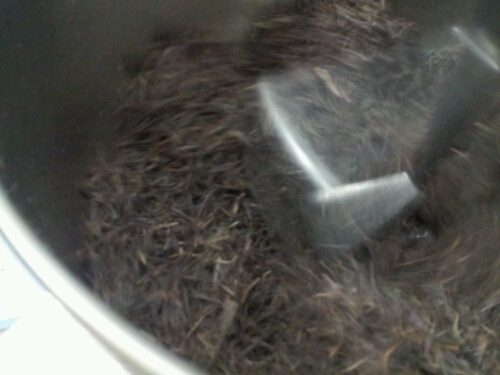The Kitchenaid as Thresher: Notes on Micro-Scale Grain Harvest
Last year I brought home an armload of ripe cheatgrass (Bromus tectorum) and some kinda fescue (Festuca sp.), because I’d never tried foraging grains before. Tom Elpel notes that all grasses are edible with the possible exception of ryegrass (Lolium spp.). Ryegrass has distinctive seed heads with neatly alternating spikelets, so it’s easy to avoid.
Grass seeds are designed to fall off the stalk or be caught by a passing animal when they’re ripe; each seed is wrapped in a little hull with protruding bits called an awn that help them disperse. Take the seed heads home, find an undisturbed corner, and let the seeds fall out onto a sheet while they dry.
This falling out process of course is not neat; you will have a bunch of seeds, and straw, and some seeds will be stuck to the straw still so you have to smash and winnow. I tried putting all of this stuff into an old pillowcase and beating it, which… sort of helped to break the straw down but mostly served to embed bits of straw and grass seeds into the pillowcase. Cheatgrass in particular is very pointy and likes to get stuck in things.
I also tried threshing by spreading the grains onto a cookie sheet and using a rolling pin, and my feet, to separate the grain from the chaff. I manually picked out some of the straw. I ran the stuff in small batches in my little food processor – this worked OK for fescue, but cheatgrass is so long and skinny, and has such long awns, that it just sort of rotated around as a single tangled mass.
Anyway, none of these techniques worked very well, but by the time I’d run out of ideas I had managed to reduce the amount of straw enough that I could put the grass away for a while. Had I been thinking I would probably have cut the straw longer when I harvested, so that I could just grab a handful of grass and flail it around in a box – I don’t expect that to be a very good way of handling cheatgrass awns but it might at least make it easier to separate out most of the straw.
Today I pulled out some of the cheatgrass, spread it on a cookie sheet, and baked it in a low (170F) oven for 90 minutes – a trick I’d read about for oat hulls. It worked! I could rub some of the seeds in my hands and feel the awns and hulls loosening.
I finished threshing with the plain metal beater on my Kitchenaid. It didn’t remove all the hulls, but after half an hour or so, the awns were broken down and the only remaining parts of the hulls were wrapped closely around the grains. Good enough.
I winnowed in the breeze in my back yard. I know I dropped some seeds. I don’t really worry about transporting seeds the short distance from the bike trail to my lawn, which is already infested with all manner of invasives anyway – but if you’re bringing seeds home from farther away, or you care about the grass mix in your lawn, uh, maybe be careful about the species you choose to harvest. I don’t think there’s any practical way to do this without losing a few.
Finally, I put half a cup of the grain into my rice cooker with two cups of water, and wound up adding another cup when that was gone. It probably wouldn’t’ve hurt to use even more. The grain tastes good, in a vague cereal flavor sort of way, but the remaining hulls give it a rough, scratchy mouthfeel.
I have a flour grinder, so I think that’s what I’ll do with the rest of it. Cheatgrass is high in gluten so maybe I’ll try to bake a mini loaf of bread.

erica wrote:
Cool! Always you seem to be reading my mind, in advance a few months. I have been very interested in grasses lately.
Posted 04 Aug 2020 at 5:49 am ¶